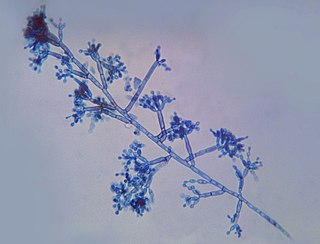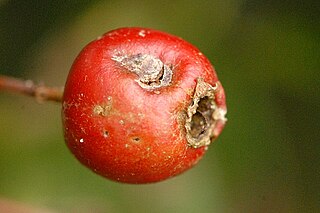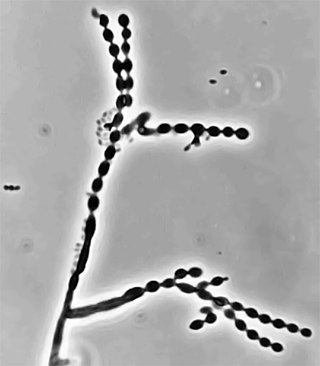
Eurotiomycetes is a large class of ascomycetes with cleistothecial ascocarps within the subphylum Pezizomycotina, currently containing around 3810 species according to the Catalogue of Life. It is the third largest lichenized class, with more than 1200 lichen species that are mostly bitunicate in the formation of asci. It contains most of the fungi previously known morphologically as "Plectomycetes".

The Chaetothyriales are an order of ascomycetous fungi in the class Eurotiomycetes and within the subclass Chaetothyriomycetidae. The order was circumscribed in 1987 by mycologist Margaret Elizabeth Barr-Bigelow.

The Venturiaceae are a family of fungi in the order Venturiales. Several of the species in this family are plant pathogens.

The Pleosporales is the largest order in the fungal class Dothideomycetes. By a 2008 estimate, it contained 23 families, 332 genera and more than 4700 species. The majority of species are saprobes on decaying plant material in fresh water, marine, or terrestrial environments, but several species are also associated with living plants as parasites, epiphytes or endophytes. The best studied species cause plant diseases on important agricultural crops e.g. Cochliobolus heterostrophus, causing southern corn leaf blight on maize, Phaeosphaeria nodorum causing glume blotch on wheat and Leptosphaeria maculans causing a stem canker on cabbage crops (Brassica). Some species of Pleosporales occur on animal dung, and a small number occur as lichens and rock-inhabiting fungi.

Capnodiales is a diverse order of Dothideomycetes, initially based on the family Capnodiaceae, also known as sooty mold fungi. Sooty molds grow as epiphytes, forming masses of black cells on plant leaves and are often associated with the honeydew secreted by insects feeding on plant sap. This diverse order has been expanded by the addition of several families formerly thought unrelated and now also includes saprobes, endophytes, plant pathogens, lichens and rock-inhabiting fungi. The new additions include the genus Mycosphaerella containing the causal agents of several economically important crop and tree diseases. A small number of these fungi are also able to parasitise humans and animals, including species able to colonise human hair shafts.
Capronia is a genus of fungi in the family Herpotrichiellaceae. It has about 80 species.
Salsuginea is a genus of fungi in the class Dothideomycetes. The relationship of this taxon to other taxa within the class was unknown in 2007. Until Kevin D. Hyde & Tibpromma, 2013 introduced family Salsugineaceae within the order of Pleosporales.
Polytolypa is a monotypic genus of fungus containing the single species Polytolypa hystricis. First classified in the Onygenaceae family, as of 2008 it is considered to be in the Ajellomycetaceae, although there is still uncertainty as to its phylogenetic relationships with other similar genera. This species is only known from a single specimen derived in the laboratory from a specimen of dung of the North American porcupine, Erethizon dorsatum, collected in Ontario, Canada. Polytolypa hystricis contains bioactive compounds that have antifungal activity.

Pestalotiopsis is a genus of ascomycete fungi in the Sporocadaceae family.
Black yeasts, sometimes also black fungi, dematiaceous fungi, microcolonial fungi or meristematic fungi is a diverse group of slow-growing microfungi which reproduce mostly asexually. Only few genera reproduce by budding cells, while in others hyphal or meristematic (isodiametric) reproduction is preponderant. Black yeasts share some distinctive characteristics, in particular a dark colouration (melanisation) of their cell wall. Morphological plasticity, incrustation of the cell wall with melanins and presence of other protective substances like carotenoids and mycosporines represent passive physiological adaptations which enable black fungi to be highly resistant against environmental stresses. The term "polyextremotolerance" has been introduced to describe this phenotype, an example of which is the species Aureobasidium pullulans. Presence of 1,8-dihydroxynaphthalene melanin in the cell wall confers to the microfungi their characteristic olivaceous to dark brown/black colour.

Sporothrix is a ubiquitous genus of soil-dwelling fungus discovered by Schenck in 1898, and studied in more detail by Hektoen and Perkins. The first described and best known species is Sporothrix schenckii, the causative agent of rose handler's disease. New environmental, and pathogenic, species have been discovered with the potential for more to be found as molecular techniques advance.
Myrmecridium is a genus of fungi in the class Sordariomycetes. It was circumscribed in 2007 and is distinguished from similar fungi by having entirely hyaline (translucent) vegetative hyphae and widely scattered, pimple-shaped denticles on the long hyaline rachis. The generic name derives from a combination of the Ancient Greek word "myrmekia", meaning "wart", and the suffix "-ridium" from "Chloridium".

Teratosphaeriaceae is a family of fungi in the order Mycosphaerellales.
Capronia mansonii is a mesophilic black yeast that is a part of the Herpotrichiellaceae. The species is uncommon in nature but is saprotrophic in nature and been discovered on decaying plant matter, particularly wood. This fungus is naturally found in the Netherlands and has successfully been cultured in lab. It is a teleomorph of the ascomycota division and possesses brown spores.

Cladophialophora is a genus of fungi in the family Herpotrichiellaceae. It has 35 species. The genus contains black yeast-like fungi, some of which are species of important medical significance. Cladophialophora bantiana causes the rare brain disease cerebral phaeohyphomycosis. Cladophialophora carrionii is a common cause of chromoblastomycosis in semi-arid climates. Some of the species are endophytes–associating with plants. For example, Cladophialophora yegresii is a cactus endophyte, which is sometimes introduced into humans via cactus spines.

Rhinocladiella is a genus of fungi in the family Herpotrichiellaceae. It has 17 species. The genus was circumscribed by Swedish botanist John Axel Nannfeldt in 1934 with R. atrovirens as the type species.
Dactylaria is a genus of fungi belonging to an unknown family. According to Wijayawardene et al. 2020; the genus was placed in order Helotiales genera incertae sedis.
Calcarisporiellaceae is a family of fungi within the subkingdom Mucoromycota. It is the only family in the order Calcarisporiellales, class Calcarisporiellomycetes, subphylum Calcarisporiellomycotina and phylum Calcarisporiellomycota. It contains two known genera, Calcarisporiella and Echinochlamydosporium. The two genera each have one species.

Coniothyriaceae is a family of ascomycetous marine based fungi within the order of Pleosporales in the subclass Pleosporomycetidae and within the class Dothideomycetes. They are pathogenic or they can be saprobic on dead branches. They are generally a anamorphic species.









